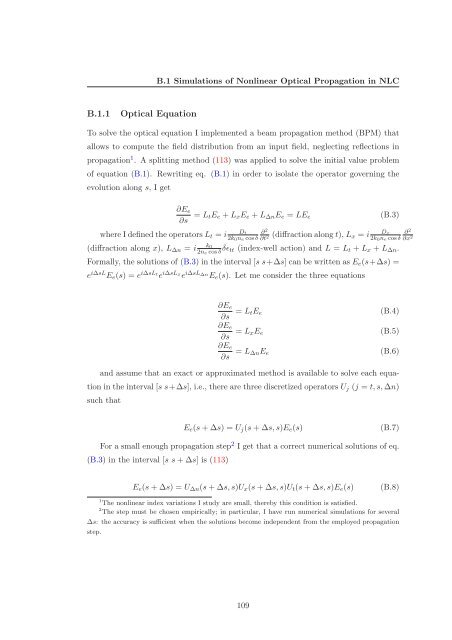Solitons in Nonlocal Media
Solitons in Nonlocal Media
Solitons in Nonlocal Media
You also want an ePaper? Increase the reach of your titles
YUMPU automatically turns print PDFs into web optimized ePapers that Google loves.
B.1.1 Optical Equation<br />
B.1 Simulations of Nonl<strong>in</strong>ear Optical Propagation <strong>in</strong> NLC<br />
To solve the optical equation I implemented a beam propagation method (BPM) that<br />
allows to compute the field distribution from an <strong>in</strong>put field, neglect<strong>in</strong>g reflections <strong>in</strong><br />
propagation 1 . A splitt<strong>in</strong>g method (113) was applied to solve the <strong>in</strong>itial value problem<br />
of equation (B.1). Rewrit<strong>in</strong>g eq. (B.1) <strong>in</strong> order to isolate the operator govern<strong>in</strong>g the<br />
evolution along s, I get<br />
where I def<strong>in</strong>ed the operators Lt = i<br />
(diffraction along x), L∆n = i<br />
∂Ee<br />
∂s = LtEe + LxEe + L∆nEe = LEe<br />
(B.3)<br />
Dt ∂<br />
2k0ne cos δ<br />
2<br />
∂t2 Dx ∂ (diffraction along t), Lx = i2k0ne<br />
cos δ<br />
2<br />
∂x2 k0<br />
2ne cos δδǫtt (<strong>in</strong>dex-well action) and L = Lt + Lx + L∆n.<br />
Formally, the solutions of (B.3) <strong>in</strong> the <strong>in</strong>terval [s s+∆s] can be written as Ee(s+∆s) =<br />
e i∆sL Ee(s) = e i∆sLt e i∆sLx e i∆sL∆nEe(s). Let me consider the three equations<br />
∂Ee<br />
= LtEe<br />
(B.4)<br />
∂s<br />
∂Ee<br />
= LxEe<br />
(B.5)<br />
∂s<br />
∂Ee<br />
= L∆nEe<br />
(B.6)<br />
∂s<br />
and assume that an exact or approximated method is available to solve each equa-<br />
tion <strong>in</strong> the <strong>in</strong>terval [s s+∆s], i.e., there are three discretized operators Uj (j = t, s,∆n)<br />
such that<br />
Ee(s + ∆s) = Uj(s + ∆s, s)Ee(s) (B.7)<br />
For a small enough propagation step 2 I get that a correct numerical solutions of eq.<br />
(B.3) <strong>in</strong> the <strong>in</strong>terval [s s + ∆s] is (113)<br />
Ee(s + ∆s) = U∆n(s + ∆s, s)Ux(s + ∆s, s)Ut(s + ∆s, s)Ee(s) (B.8)<br />
1 The nonl<strong>in</strong>ear <strong>in</strong>dex variations I study are small, thereby this condition is satisfied.<br />
2 The step must be chosen empirically; <strong>in</strong> particular, I have run numerical simulations for several<br />
∆s: the accuracy is sufficient when the solutions become <strong>in</strong>dependent from the employed propagation<br />
step.<br />
109
















